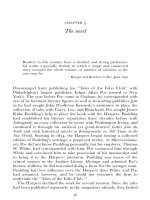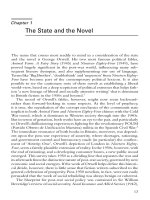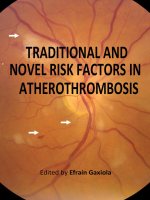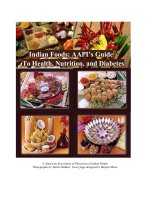2c novel foods and novel foods ingredients
Bạn đang xem bản rút gọn của tài liệu. Xem và tải ngay bản đầy đủ của tài liệu tại đây (496.46 KB, 21 trang )
Novel Foods
Description
Authorization process, labelling
What the Novel Food Regulation does not cover
Decisions: Authorizations and refusals, open status applications
Finnish and South American examples
Points to consider
A revision proposal of the novel foods legislation (Dec 2013) and its criticism
Novel foods Anna-Leena Salmela
Description
/>
The Commission considers foods and food ingredients that have not been used for human consumption to a significant
degree in the EU before 15 May 1997 novel foods and novel food ingredients.
Applies to foods and food ingredients which satisfy the decription and fall into one of the following categories:
Foods and food ingredients
•which present a new or modified primary molecular structure;
•which consist of micro-organisms, fungi or algae;
•which consist of or are isolated from plants and ingredients isolated from animals;
•whose nutritional value, metabolism or level of undesirable substances has been significantly changed by the
production process.
They:
Must be safe for consumers.
Must be properly labelled to not mislead consumers.
Can not be nutritionally disadvantageous.
What the Novel Food Regulation does not cover
The Regulation does not cover :
•Food additives
•Flavourings for use in foods
•Extraction solvents used in the production of foods
•GMOs for food and feed
If foods and/or food ingredients were used exclusively in food supplements, new uses in other foods require
authorisation under the Novel Food Regulation e.g. food fortification require authorisation.
Authorisations
Only authorised novel foods may be placed on the market.
Companies must apply to a EU country authority for authorisation, presenting the
scientific information and safety assessment report.
The competent authority of the EU country makes the intial risk assessment and
decides if additional assessment is necessary.
The report of initial assessment is circulated in all EU countries for comments.
Marketing of the product is allowed if no additional assessment is necessary, and if the
Commission and EU member countries do not object.
If concerns are raised, additional risk assessment is made by EFSA (2/3 of all cases).
Average time from application to a final decision 18-24 months.
Authorization is specific to a particular product. Only the applicant is allowed to place
the product on the market.
Authorisations
Authorisation covers:
• Conditions of use
• Designation of novel food or novel food ingredient
• Specification and labelling requirements
Simplified procedure - notification
A novel food or ingredient may be marketed through a simplified procedure called "notification". The company notifies
the Commission about their marketing a novel food or ingredient based on "substantial equivalence“ (scientific
evidence required).
Labelling
Requirements for labelling of novel food and ingredients are additional to the general EU requirements on food
labelling.
Where necessary, labelling of novel food and novel food ingredients may mention:
• Characteristics - composition, nutritional value, intended use;
• Materials which may affect the health of some individuals;
• Materials that give rise to ethical concerns.
Safeguard measure
If a EU country considers a novel food or ingredient a risk to human or environmental health because of new
information, it may suspend or temporarily restrict the marketing and use of any novel food or ingredient on their
territory.
The country informs the Commission which either extends the national measures to all EU countries or asks that they
are repealed.
Novel foods and novel foods ingredients – Authorisations
/>
Foods that may be placed on the market in the EU
(Regulation (EC) No. 258/97 Article 4.2 first indent)
2012
•DHA and EPA rich oil from the microalgae Schizochytrium
•Synthetic Vitamin K 2
•Krill oil (extension of uses)
2011
•Arachidonic acid-rich oil from the fungus Mortierella alpina
•Magnolia bark extract
•Zinc L-pidolate
•Wheat bran
2010
•Guar gum
•Sucromalt
2005
•D-Tagatose
Authorisations of novel foods and novel food ingredients by Commission Decisions
” the placing on the market of…as a novel food ingredient”
(Finnish applications, Southern American plants)
2013
•zeaxanthin
•an extension of use of Chia ( Salvia hispanica ) seed
2012
•bovine lactoferrin
•dihydrocapsiate
•Gamma-Cyclodextrin
•novel chewing gum base
2011
•novel chewing gum base
•yeast beta-glucans
•Phosphatidylserine from soya phospholipids
•fermented black bean extract
•phosphated maize starch
•Chromium Picolinate
•chitin-glucan from Aspergillus niger
•mycelial extract from Lentinula edodes (Shiitake mushroom)
•Chromium Picolinate ingredient
•a fish (Sardinops sagax) peptide product
•a chitin-glucan from Aspergillus niger
•a mycelial extract from Lentinula edodes (Shiitake mushroom)
2010
•ferrous ammonium phosphate
•Ferric Sodium EDTA
•puree and concentrate of the fruits of Morinda citrifolia (Noni)
2009
•Chia seed (Salvia hispanica)
•a leaf extract from Lucerne (Medicago sativa) sinimailanen
•the uses of algal oil from the micro-algae Schizochytrium sp.
•the uses of algal oil from the micro-algae Ulkenia sp.
•a lipid extract from Antarctic Krill Euphausia superba
•lycopene
•lycopene from Blakeslea trispora
•lycopene oleoresin from tomatoes
•lycopene as a novel food ingredient
•Ice Structuring Protein type III HPLC 12
•Vitamin K2 (menaquinone) from Bacillus subtilis natto
2008
•leaves of Morinda citrifolia (Noni)
•arachidonic acid-rich oil from Mortierella alpina (belong to soil fungi)
•Baobab dried fruit pulp (a tree native to Africa, Australia, Madagaskar, Arabian Peninsula)
•allanblackia seed oil (flowering plant in the Clusiaceae family, African)
•refined echium oil (a genus of 60 species of flowering plant in the family Boraginaceae. Native to North Africa, mainland
Europe and the Macaronesian islands)
•alpha-cyclodextrin
•rice drinks with added phytosterols/phytostanols (Teriaka Ltd)
2006-2007
•oil enriched with phytosterols/phytostanols
•diacylglycerol oil of plant origin
•lycopene from Blakeslea trispora
•rapeseed oil high in unsaponifiable matter
•maize-germ oil high in unsaponifiable matter“
•foods and food ingredients derived from genetically modified maize line MON 863
•rye bread with added phytosterols/phytostanols (Fazer, Pharmaconsult)
•foods and food ingredients produced from genetically modified Roundup Ready maize line GA21
2004-2005
•isomaltulose
•foods and food ingredients derived from genetically modified maize line NK 603
•milk based beverages with added phytosterols/phytostanols
•sweet corn from genetically modified maize line Bt11
•yellow fat spreads, milk based fruit drinks, yoghurt type products and cheese type products with added
phytosterols/phytostanols (Teriaka Ltd)
•milk type products and yoghurt type products with added phytosterol esters
•yellow fat spreads, milk type products, yoghurt type products, and spicy sauces with added phytosterols/phytostanols
(Pharmaconsult Oy Ltd. (formerly MultiBene Health Oy Ltd))
•yellow fat spreads, salad dressings, milk type products, fermented milk type products, soya drinks and cheese type
products with added phytosterols/phytostanols
2000-2003
•Salatrim
•oil rich in DHA
•'noni juice'
•coagulated potato proteins and hydrolysates thereof
•dextran preparation produced by Leuconostoc mesenteroides.
•pasteurised fruit-based preparations produced using high-pressure pasteurisation.
•trehalose
•"yellow fat spreads with added phytocolesterol esters"
•"phospholipides from egg yolk"
Refusals of authorisation of novel foods and novel food ingredients by Commission
Decisions
2000-2005
•Betaine
•"Nangai nuts" Canarium indicum L (dried seed kernels)
/>
•Stevia rebaudiana Bertoni plants and dried leaves
/>
Note! Usage of steviol glycosides from leaf extracts as sweeteners has been accepted (since 2.12.2011, EU food
additive legislation)
Summary of Finnish applications and applications concerning Southern American
plant-based products (authorized, withdrawn)
EU pages (updated 25.6.2012)
/>
EVIRA http://
www.evira.fi/files/attachments/fi/elintarvikkeet/valmistus_ja_myynti/uuselintarvikkeet/uuselintarvikehakemukset.pdf
authorized
•vegetable oil from Inca Inchi (Sacha Inchi) (Plukenetia volubilis linneo), 2013
•Chia seed (extension of use), 2013
•Morinda citrifolia L. (Noni) Fruit puree and concentrate (extension of use), 2010
•leaves of Morinda citrifolia (Noni), 2008
•rice drinks with added phytosterols/phytostanols, (Teriaka Ltd) 2008
•rye bread with added phytosterols/phytostanols (Fazer, Pharmaconsult), 2006
•yellow fat spreads, milk based fruit drinks, yoghurt type products and cheese type products with added
phytosterols/phytostanols, (Teriaka Ltd) 2004
•yellow fat spreads, milk type products, yoghurt type products, and spicy sauces with added
phytosterols/phytostanols, (MB Multibene Health Oy Ltd) 2004
Examples of open status
•Fresh dried Noni powder
•Juices and nectars with added phytosterols
•Glucosamine hydrochloride from Aspergillus niger
•Conjugated Linoleic Acid (CLA)
•Policosanol
•Cis-9-cetyl myristoleate
•CLA
•Lactoferrin
•D-Ribose
•Astaxanthin
•Methyl Vinyl Ether-Maleic Anhydride Copolymer
•Glicine propionyl L-Carnitine hydrochloride
•Arracacia xanthorrhiza (with objections, is undergoing EFSA consultation)
•Isomaltooligosaccharide
•Bee venom
•L-Theanine
•Pectine-derived Acidic Oligosaccharide
•Taxifolin
•Selenitetriglycerides
•Rooster combs extract
•Modified apple drink
•Tetrasemilis chuii (microalga)
•Nannochloropsis gaditana (micro-alga)
•Coriander seed oil
•Cranberry extract powder
•
•
•
•
•
•
•
•
•
•
•
•
•
•
•
•
•
Hydroxypropyl methyl cellulose (HPMC)
(6S)-Methyltetrahydrofolic acid, Glucosamine salt
Clostridium butyricum as an ingredient to food supplements
Oil from the crustacea Calanus finmarchicus
UV treated yeast
Citicoline
Tolerase
Rapeseed protein
UV treated bread
Methyl Cellulose
Resveratrol
UV treated milk
Chia oil (applied 2012)
Pyrroloquinoline Quinone Disodium Salt)
Milk based products with Bacteroides xylanisolvens
Astaxanthine
UV-treated bread with vitamin D
Applications 2014
•
Peels of Sporopollen
•
Lacto-N-neotetraose
•
Phospholipide-rich krill oil
•
Cycloastragenole
•
EstroG-100
•
Novel use of Glavonoid
•
Nattokinase (fermented soy bean extract)
•
Hovenia dulcis (applications not accepted by any country)
Novel Food Catalogue
/>
•lists products of plant and animal origin and other substances subject to the Novel Food Regulation, after EU countries
and the Commission agree in the Novel Food Working Group.
•non-exhaustive, and serves as orientation on whether a product will need authorisation under the Novel Food
Regulation.
•EU countries may restrict the marketing of a product through specific legislation. For information, businesses should
address their national authorities.
•In some cases, it shows EU countries' history of use of food supplements and ingredients used exclusively in food
supplements.
•If foods and/or food ingredients were used exclusively in food supplements, new uses in other foods require
authorisation under the Novel Food Regulation.
Points to consider (from Hermann M. The impact of the European Novel Food Regulation on trade and food innovation based on
traditional plant foods from developing countries. Food Policy 34 (2009) 499-507.)
•Market access outside EU (many of the novel foods available in Canada, USA,
Switzerland and Japan), re-directing of the marketing due to restrictions in Europe?
•Importance of traditional exotic foods to the economics of poor countries and to the diet
diversification among EU consumers? The regulation is critized being a non-tariff trade barrier for
food that is “exotic” from the EU perspective.
•Would separate categories be needed for exotic traditional foods and ”true” novel, innovative
foods with no long-term consumption outside the EU?
- Now extensive data is required of composition, nutritional aspects, intake, toxicology
and allergenic potential, also for products that are generally regarded as safe (GRAS) outside the EU
- Are the requirements even stricter than those required for accepted traditional
European foods?
- Are the scientific requirements proportionate to the potential risks they pose?
- Currently, the history of safe use outside the EU is not considered - should traditional
knowledge be admitted for food safety assessment?
- Lack of peer-reviewed publications, lack of data from certified laboratories – should
be taken into account in project design, product development and trade promotion
- Traditional knowledge from the local people should be used.
•Would the potato be authorized nowadays (glycoalcaloids)? Wheat (gluten)?
Table 1. Edible minor plant species from Andean South America not yet widely traded internationally
(Hermann M. The impact of the European Novel Food Regulation on trade and food innovation based on traditional plant foods from developing countries.
Food Policy 34 (2009) 499-507.)
Note! Yacon is not considered
novel food and can be traded
to EU (since beginning of 2014)
Plants not subject to NFR: oca, maca (decision 2008), lucuma, lulo (Naranjilla), cupuacu
Why are these not widely traded?
Which would have most potential?
not subject to NFR according to Evira pages: goji, acai berry, ginseng, chaqa mushroom (Inonotus obliquus, as food additive
and tea)
Plants requiring authorization: ungurahua, peach palm, (camu camu)
Very interesting link to Andean plants (although old)
/>Lost Crops of the Incas:
Little-Known Plants of the Andes with Promise for Worldwide
Cultivation (1989)
Noni
By 2003
In 2004
In 2008
By 2009
only 1 traditional food product was authorized: noni juice by Morinda Inc (2003)
Other noni products require separate authorization
application for the use of noni leaves as herbal tea submitted by Morinda Inc
authorization of the use noni leaves as herbal tea
substantial equivalence of products from 48 companies to those of Morinda Inc demonstrated,
resulted in authorization (33 from Europe, 7 from Polynesia, 3 from USA,
3 from Central America and Caribbean, 1 from New Zealand, 1 from Switzerland)
source: Hermann M. Food Policy 34 (2009) 499-507
Now also noni puré and concentrate authorized
Table 2. Promising minor crops challenged by EU Regulation 258/97
(Hermann M. Food Policy 34 (2009) 499-507.)
Maca: Decision 2008, not subject to NFR
The European Commission has proposed a revision of the novel foods legislation in Dec 2013
The key changes would be the following:
•Definition of novel food: Novel foods are to be defined as foods that were not used for human
consumption to a significant degree within the EU before 15 May 1997 and that would be the sole
criterion for classification as a novel food. Categories would not be qualifying factors anymore.
•Approval Process: The process would be centralized. Authorisations would be applied directly from
European Commission which would then prepare proposal for authorisation or rejection based on
EFSA safety evaluation, within 9 months after receiving the evaluation. This would then require
the approval of a Standing Committee composed of representatives of Member State governments.
•Categories: included as examples rather than as a requirement that the food must fall into one of
the categories to be considered novel.
•Responsibility: Food Business Operators (FBOs) would determine whether or not a food intended
to be placed on the market is a novel food. Companies would contact the Member State authorities
if any doubt exists. They would then request information be provided to prove use before 15 May 1997.
•Third country foods: a simplified procedure for placing on the market traditional foods from third
countries. Minimum of 25 years as part of customary diet in a large part of any third country would
indicate history of safe use.
European Federation of Associations of Health Food Products Manufacturers (EHPM) Briefing Paper 2014
/>
criticism of the revision proposal of European Commission
•Lack of categories:
According to the proposal, categories are not used to define novelty of food. This would deny countless
products from the market access without no true safety concern
New proposal: categories are needed and they will need to be fine-tuned. The extent to which the novel
food system can be applied to plant extracts should be clarified.
•Definition:
“used to significant degree…” What is significant? Companies are only required to keep accounts dating bac
a period of 7 years. Evidence of sales through pharmacies is given more importance than other channels.
New proposal: guidance from the commission should be revised to take all channels of distribution
into account.
•Lack of timeframe for decision:
No timeframe for a Standing Committee to make the decision based on a proposal
from the Commission decision.
New proposal: timeframe of 5-9 months should be set for a Standing Committee decision.
•Borderline, novel vs medicinal food
Member states are able to classify certain products containing a novel food as medicinal based on
the functionality of the novel food. Therefore, the product can stay out of the market in certain
member states despite authorisation.
New proposal: This internal trade barrier should be addressed and guarded against.









